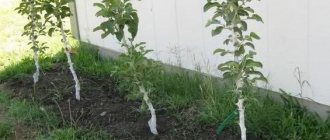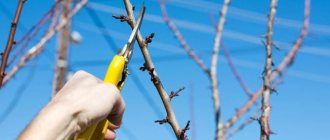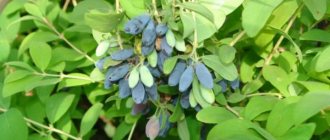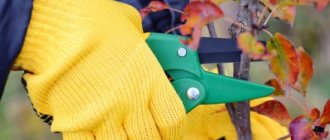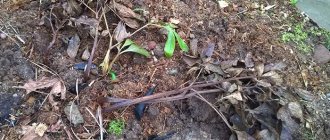8098
It does not take much time to prune paniculate hydrangea in spring or autumn. This procedure allows you to renew the bush and stimulate the formation of new large inflorescences. Hydrangea is formed in the form of a spreading tree or shrub. If you do not trim on time, the abundance of annual shoots will lead to shredding of the inflorescences.
Variety Pinky Winky, formed in the form of a trunk
Main types of garden hydrangeas with names and photos
This garden plant has several dozen different species, approximately 80 in total. But the most famous and widespread are only a few (photos and names of varieties are presented below). So, the most popular are:
- Treelike is an ornamental shrub with spectacular and lush inflorescences. Flowering period is from July to October. Easily tolerates harsh winter conditions. Grows well in both partial shade and sun. The plant forms new inflorescences on the current year's shoots. The most popular varieties of tree hydrangea: Annabelle, Pink Annabelle (you can see photos of these varieties of hydrangeas below).
- Paniculata is an incredible plant with gorgeous cone-like inflorescences. Inflorescences are divided into small (bisexual) and large (sterile). During flowering, paniculate hydrangea inflorescences can gradually change color from white to soft pink, and then to bright pink. A magical sight! New inflorescences form on the shoots of the current year. The most popular varieties of paniculate hydrangea are: “Pinky Winky”, “Bobo”, “Diamond Rouge” (photos of varieties are presented below). Varieties of beautiful hydrangea “Pinky Winky”, “Bobo”, “Diamond Rouge” will decorate any garden.
- Large-leaved (garden) - a gorgeous plant that can change the color of flowers. For example, a pink flower can turn blue or blue, and a red flower can turn purple. This occurs due to a decrease or increase in soil acidity. But large-leaved hydrangea with white inflorescences cannot be painted and does not change color. Inflorescences appear on last year's shoots. Therefore, if the shoots were cut off or frozen in winter, the hydrangea will not bloom. Large-leaved hydrangeas are pruned in the fall. The plant must be covered for the winter. This information is especially relevant for beginners. Because experienced gardeners know that large-leaved hydrangea is a very finicky plant. And it must be carefully looked after.
Paniculata hydrangea is the most winter-hardy plant species.
These types of hydrangeas are much less common:
- Oakleaf - this type of hydrangea is similar to paniculate inflorescences and has a delicate and subtle aroma. This is the main “highlight” of the plant. The leaves of oakleaf hydrangea are somewhat similar to oak leaves. They feel like velvet to the touch. There is one more feature. It lies in the fact that the leaves are bright green in summer, but with the onset of autumn they acquire a burgundy color, which looks very impressive in the garden. Unfortunately, this type of hydrangea is not common. But it must be said that it belongs to the frost-resistant species.
- Serrated - this hydrangea, like the large-leaved one, is capable of changing color due to the acidity of the soil. From soft blue to lilac. She needs shelter for the winter.
- Petiolate (garden vine) - this hydrangea can grow 20 meters in height.
- Sargenta - This plant blooms with beautiful pale purple flowers. The leaves are very large. For the winter, hydrangea must be covered.
Petiole hydrangea is able to absorb all nutrients not only through the root system, but also through aerial roots. But this plant is not particularly winter-hardy. The garden vine blooms with large white inflorescences. They emit a dizzying aroma that attracts insects.
Hydrangea has unusually beautiful flowering
There are varieties of large-leaved hydrangea that bloom twice: first on the shoots of the previous year, then on the shoots of the current year, for example, the varieties “Endless Summer”, “Liberteen”, “Fireworks Pink”. Therefore, such varieties are not afraid of spring pruning. You can see photos of the varieties below.
Favorite varieties of gardeners: “Endless Summer”, “Liberteen”, “Fireworks Pink”
Why do hydrangeas need to be pruned?
If the hydrangea is not pruned, then it will take on a neglected and ugly appearance. The inflorescences will become small and flowering will decrease. But thanks to pruning, the inflorescences will be large and lush. Main tasks when pruning:
- Plant rejuvenation.
- Crown formation.
- Pruning for powerful growth of new shoots.
- Thinning.
- Removing frozen and weak branches.
After spring rejuvenating pruning of hydrangea paniculata there will be few flowers, but they will be very large.
Anti-aging pruning
Hydrangea paniculata bushes older than 10-12 years need rejuvenation. If the trunk is too thick, it is replaced with a single young shoot, which is cut “to the stump”. Beginner gardeners ask the question: won’t the bush die if the above-ground part is completely cut off for the purpose of rejuvenation and one shoot is left? The answer from experts is that the plant does not die; it completely restores the strength of the branches the next year. Further formation of the bush is carried out in the same way as it was done initially.
When to prune hydrangeas in spring and autumn - dates by month
For many gardeners, especially beginners, questions such as: when is the best time to prune hydrangeas? In autumn or spring? How to prune correctly? And in what months should it be carried out?
So, the main pruning of plants is carried out in early spring, after the snow has melted, but before the sap begins to flow, around the end of March. Large-leaved hydrangea does not need to be pruned in the spring, since new inflorescences grow from the upper buds. You can only do a little cosmetic pruning. Below you can watch a video for beginners on how to prune hydrangeas in the spring.
Instructions for those who do not know how to prune hydrangeas
Tree and paniculate hydrangeas can be pruned in both autumn and spring.
In autumn, old inflorescences, broken branches and shoots growing inside the crown of tree or paniculate hydrangea are usually carefully removed.
You can see how to properly prune hydrangeas in this video.
Caring for hydrangea in the fall and preparing for winter. In a special publication on our portal, we will talk in detail about how to care for hydrangeas in the autumn and how to properly prepare them for wintering; learn about caring for hydrangeas in the spring during the recovery period.
Recommendations
Experienced gardeners believe that autumn pruning is an integral part of shrub care. But for this procedure to benefit the plant, it must be carried out taking into account all the recommendations.
This video will help you properly prune tree hydrangea in autumn:
Basic recommendations:
- During the forming procedure, you should adhere to a hemispherical shape, that is, cut the outer shoots a little shorter than the central ones.
- At the base of the branches of this type of crop, two buds are often located too close. Therefore, the count must be carried out higher, without taking them into account, otherwise this may lead to thickening of the crown.
- Pruning should be done in dry weather in the morning so that the wounds have time to heal and do not become infected.
- The procedure should not be carried out in early autumn, as this may lead to the resumption of bush vegetation. Re-growth of shoots will significantly weaken the bush before winter.
- Autumn pruning does not exclude its implementation in the spring. With the arrival of warmer weather, it is necessary to remove all frozen and broken branches.
Important! This type of crop requires regular cleaning of the crown, since, unlike others, it grows very quickly.
General rules and recommendations for pruning hydrangeas of different ages
Proper pruning will help give the plants the correct bush shape. The inflorescences will be large and beautiful. Here are the general rules:
- Hydrangea bushes are trimmed only with sharp and clean pruning shears, so as not to cause significant wounds to the plant.
- Under no circumstances should you cut off hydrangea branches.
- Last year's inflorescences and weak and frozen branches should be trimmed in good weather. But it is advisable to do this before the sap flow begins. For example, in October or March. At this time, the plant is dormant.
- Do not leave split stumps or cuts. Otherwise, the plant may die. Be sure to treat such areas with garden varnish or its substitute.
- Thick branches of the bush need to be cut down with a hacksaw. Make sure that the edges of the cut are smooth. And also treat them with garden varnish.
- The cut should be made obliquely, at a distance of 2-3 centimeters from the buds.
- Cuts and any damage on large branches must be covered with garden varnish or some kind of substitute.
- If the hydrangea bush is large, then you need to prune the branches gradually, over 2-3 years. Otherwise, the hydrangea may die.
By following these rules in spring and fall, you can enjoy abundant hydrangea blooms all summer long.
Blooming hydrangea is an unforgettable sight
How to prune hydrangeas to form the crown of young plants
During the first 2-3 years, it is imperative to form the crown of a young plant. To do this, it is necessary to take into account species characteristics. For example, in a large-leaved plant, as mentioned earlier, you only need to cut off the faded inflorescences, without touching the new non-flowering shoots.
Paniculata can be formed into a tree. You only need to remove weak (null) branches growing from the root and shoots growing inside the bush. Strong shoots must be shortened by 1-2 buds, because the stronger the hydrangea branch, the more buds can be left on it. But if you want to form a bush, then when planting you need to deepen the hydrangea a little. After some time, new shoots will appear.
In young tree-like plants, the shoots need to be shortened just a little in the first year. It is necessary to remove diseased and frozen branches. This is done so as not to interfere with the adaptation of the plant and the growth of a powerful root mass. In the second season, the shoots are shortened and 3-4 buds are left on the branch. It is necessary to begin to form the skeletal basis of the plant in the second year.
How to prune mature hydrangeas to stimulate vigorous flowering
In mature hydrangeas, as a rule, flowering may decrease. The once lush and luxurious inflorescences become smaller and are no longer pleasing to the eye. This problem can be solved using the same pruning.
- It is necessary to remove last year's old shoots, leaving only 2 or 3 buds. New shoots will then grow in this place with powerful flowering.
- Don't forget about dry and frozen branches. You need to get rid of them too.
- To ensure that the plant has enough light, prune thickening branches and branches growing inside the bush.
- Old shoots growing from the roots can be carefully removed to the base.
After these events, hydrangea will begin to bloom beautifully again
How to perform radical pruning to rejuvenate old or diseased plants
Old or disease-damaged hydrangea bushes can be rejuvenated. To do this you just need to do some radical pruning. In this case, the plant is cut down to the stump, removing old, large shoots (just do this with a hacksaw. And do not forget to cover the cuts with garden varnish). But fresh shoots must be left.
Radical pruning of large-leaved hydrangea in the spring will help restore the plant to its former beauty. True, the disadvantage of such pruning is that after it the plant may not bloom for one season. But don't panic. After all, this happens due to the fact that the plant forms a healthy and strong crown. In a year, lush and large inflorescences will appear again.
Pruning paniculate and tree forms
Hydrangea pruning for the winter is carried out to the same length. In autumn the bushes take on a spherical shape. In spring, twin shoots develop from two parallel buds, slightly deviated in opposite directions, but equal in inflorescence size and length. This symmetry contains the extraordinary beauty of the plant and the secret of maintaining its spherical shape. During the season, cutting and chasing of shoots is not required. Flowering lasts from early summer to late autumn.
Trimming scheme
These forms have the same pattern of flower bud formation and shoot growth.
Formation of a young bush
In the first year
In autumn, of all the grown shoots after planting, the plants leave one, the most developed one. It is shortened by 15-17 cm above the ground so that three pairs of buds remain. Over the next summer, shoots grow from the buds that will become skeletal branches. It is advisable to tie these shoots to individual stakes to form skeletal branches evenly around the circumference of the bush.
Second year
In the autumn of the second year, the branches are inspected and, if damaged, removed completely. To form branches of the third order, the skeletal branches are shortened to a length of 15 cm. Young Hydrangeas are pruned according to this scheme until they are 4-5 years old.
The further pruning scheme is as follows:
- shorten branches with inflorescences to a length of 15 cm;
- completely remove weak shoots with small flowers;
- inspect the current year's growth coming out of the ground. If you need to add young branches, leave 1-2 strong tops, cut the rest as deep as possible, digging out the branches;
- inspect the old skeletal branches - in case of shading, crossing, remove excess shoots at the base of the skeletal branch.
Experts recommend annually cutting the bush to approximately the same height of 1.2-1.4 m. These bush sizes are convenient for working with the plant without excessive hand strain.
Paniculata Hydrangea can be formed into a “tree”. To do this, the first shoot, which acts as a trunk, is left twice as long in the fall - 30 cm, with six pairs of buds. The next year, when young branches 6-7 cm long develop from the buds, the branches are completely broken out of the first three pairs of lower buds. The first tier of branches is formed at a height of 20-30 cm. Such formations are good for southern regions, where snowy winters rarely occur. The aesthetics of the tree remains at a high level throughout the entire season.
Are there any restrictions on the number of shoots per bush?
Well-rooted plants produce 20-30 shoots per season. This is an excessively large number. It is advisable to keep the number of two-year-old shoots at 9-10 from year to year. In this case, the old ones are cut out, and the new ones are removed from the basal shoots. With this cupping system, about 30 branches will bear flowers in the third year.
Features of pruning different types of hydrangeas with step-by-step instructions for beginners
When pruning shoots, you must follow all rules and recommendations. Do not forget that the pruning shear blades must be sharp. Otherwise, you risk destroying the plant. With the onset of the first warm days, prepare all the necessary tools and remove the covering material. Then you can start pruning.
How to prune large-leaved hydrangea in spring and fall
Large-leaved is the most whimsical type of this plant. She needs shelter in winter. While woody and paniculate hydrangea can winter without this. Therefore, if you are not sure when to prune large-leaved hydrangea in the spring, it is better to wait until the buds swell. Then it will be clear which branches survived the winter safely and which are best removed.
As a rule, when covering, the plant is pressed to the ground or even tied to pegs. Therefore, before pruning, you need to very carefully straighten the plant, and then you can start pruning. Remember that if the shoots are severely shortened or the shoots are pruned incorrectly, the plant may not bloom.
Pruning tree hydrangea in spring and autumn
How to prune tree hydrangea in autumn and spring? In October, when all the shoots are clearly visible, you need to prune the faded inflorescences. This is necessary so that the hydrangea does not break under the weight of snow. Next year powerful shoots will grow from them.
Tree hydrangea can be pruned in the spring. The shoots of the plant are cut by ⅓, leaving 2-3 buds. Remove all diseased and weak branches. Form a crown. This completes the spring pruning.
How to prune paniculate hydrangea correctly in spring and autumn
The paniculate hydrangea may not be pruned, but then the once large cone-shaped flowers will be crushed, and the bush will become ugly and thickened. Therefore, it is best to prune the plant. It doesn't matter in autumn or spring. The main thing is to do it. After this procedure, many new young shoots will appear. The plant will delight with its lush flowering from July to October.
It is important to cut off the shoots of the plant, leaving 3-4 buds. And also carry out formative pruning and remove all weak and diseased branches. You can watch a video of pruning hydrangea paniculata in spring.
Cuttings of hydrangeas
After pruning, many cuttings remain. Well, don’t throw away future beauty. It would be too much. So, did you know that these cuttings can be planted? Yes Yes. From them a new amazing hydrangea bush will then grow. So, here are the step-by-step instructions:
- From the cut branches you need to cut cuttings with 2 nodes.
- An oblique cut must be made under the lower bud. And above the upper bud, the cut should be straight. Don’t forget about a 2 centimeter space from the top bud.
- Then these cuttings need to be planted in a mini-greenhouse with fertile soil and watered thoroughly.
- Cover the greenhouse with cuttings with film or glass.
After the cuttings take root, you can plant them in open ground.
There is another way. The cuttings need to be placed in a container with water. Add a stimulator for root formation, for example, Epin. After some time, roots will appear. Afterwards it will be possible to plant.
What to do with broadleaf Hydrangea before winter?
The tops bear the buds of flowers; they often go into winter with leaves. After completely removing the old branches, all remaining shoots are tied compactly and slightly bent to the ground. Then they are tied with white agrofabric in two or three layers. This material allows rainwater to pass through well, so the bush is covered with polyethylene on top of it. Below, in two or three places, leave free spaces for ventilation. The covering operation is carried out before the onset of frost, before the roses are covered.




